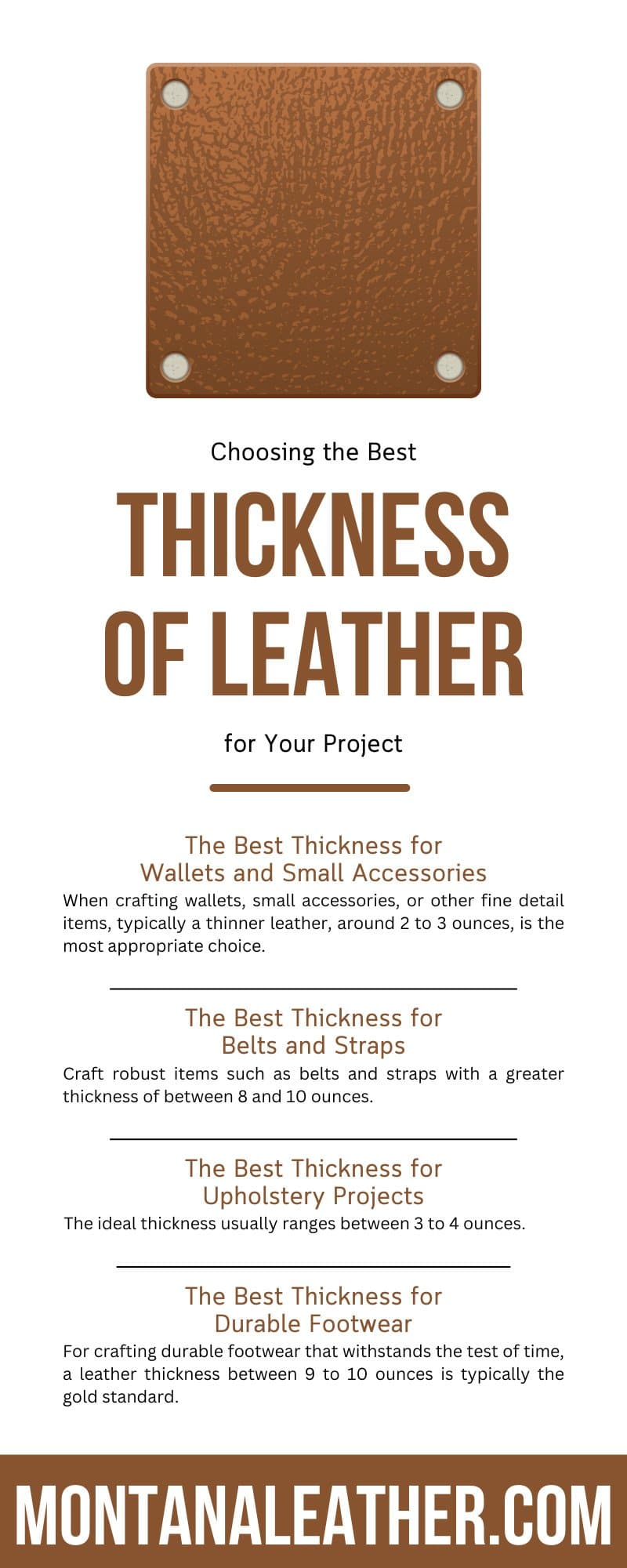
As you embark on a leather project, one crucial factor to consider is the thickness of the leather you will use. This characteristic does more than influence the project’s aesthetic—it also impacts the functionality and durability of the end product. Read on to discover a few ways to choose the best leather thickness for your project and achieve the best result.
The Importance of Leather Thickness in Crafting
Leather thickness is a pivotal aspect of crafting because it directly correlates with the crafted item’s quality, durability, and longevity. For instance, thicker leather is typically suitable for items that bear substantial weight or endure daily wear, such as belts, shoes, or saddlebags.
Conversely, thinner leather is best for delicate items such as wallets, pouches, or book covers. Understanding the relationship between the item’s intended use and the appropriate leather thickness enhances the success and satisfaction of your crafting project.
Measuring Leather Thickness
We typically measure leather thickness in ounces or millimeters. One ounce is approximately equal to 1/64th of an inch or 0.4 millimeters. For example, a 4-ounce leather hide is approximately 1/16th of an inch or 1.6 millimeters thick. This measurement derives from a special tool known as a leather gauge.
However, it’s crucial to remember that the thickness might vary slightly even within a single hide due to the natural variations in the animal’s skin. Some animal hides, including bison leather, have unique patterns in their grain or thicker fibers that may throw off the measurement. Knowing how to measure and interpret these measurements is essential for determining the appropriate thickness for your leather project.
How Leather Thickness Influences Projects
The thickness of the leather significantly influences the working process and outcome of a project. As previously, you’ll need to choose the best thickness for your leather project depending on the item you wish to craft and its purpose.
Additionally, the tools required for crafting vary based on the thickness, with thicker leathers often necessitating heavier-duty tools for cutting or stitching. Understand the impact of leather thickness on various projects so that you can make informed choices and improve the quality and longevity of specific items.
The Best Thickness for Wallets and Small Accessories
When crafting wallets, small accessories, or other fine detail items, typically a thinner leather, around 2 to 3 ounces, is the most appropriate choice. This thickness is ideal as it provides the right balance between durability and flexibility, allowing for intricate designs and detailing without compromising the overall strength of the finished item.
Additionally, thinner leather is easier to work with, requiring less force for cutting and stitching, which makes the crafting process smoother and more manageable. Since wallets and other accessories like bracelets will experience frequent use and bending, it’s best to focus on making them durable and flexible. However, the thinner leather may not withstand heavy wear and tear as effectively as those made from thicker leather and needs care to ensure longevity.
The Best Thickness for Belts and Straps
Craft robust items such as belts and straps with a greater thickness of between 8 and 10 ounces. This substantial thickness ensures that the belt or strap withstands prolonged usage and bears weight without deformation or wear. Use thicker leather, such as cowhide, for its innate durability, resilience, and aesthetically pleasing grain pattern.
The dense structure of thick leather provides a robust resistance against tears and scratches, making it ideal for the stress that belts and straps undertake. Keep in mind that the thicker layer of leather may take more effort to work with for an excellent result.
The Best Thickness for Upholstery Projects
Leather thickness is essential for upholstery projects since people want comfort when using them. The ideal thickness usually ranges between 3 to 4 ounces. This thickness provides the perfect harmony of durability and flexibility for various upholstery applications. Whether you make a vintage armchair or a modern sofa set, you need leather that is resilient enough to endure heavy usage while maintaining comfort and visual appeal.
The leather’s inherent toughness protects it from wear and tear, and the suppleness allows it to mold to the contours of the furniture, contributing to an aesthetically pleasing and comfortable finish. It’s best to use full-grain leather since it maintains the hide’s imperfect appearance that appeals to many while providing durability.
The Best Thickness for Durable Footwear
For crafting durable footwear that withstands the test of time, a leather thickness between 9 to 10 ounces is typically the gold standard. This thickness offers the robustness needed for footwear, ensuring they tolerate regular use and harsh environmental conditions without compromising comfort or style.
People often use leather footwear for outdoor activities or fashion. Use a thicker layer of leather to maintain the aesthetic appearance of boots and shoes with excellent durability. Hiking and physical labor require footwear that withstands the effort and supports a person while holding together. The thicker cut gives the footwear an appealing ruggedness, while the natural resilience ensures the shoes or boots retain shape and function over time.
The Best Thickness for Armor and Tactical Gear
When crafting armor and tactical gear, a minimum leather thickness of 10 to 12 ounces is best. This gear demands extreme durability and resistance to withstand potential dangers such as projectiles and blunt objects. Use thicker leather such as bison, buffalo, or cowhide since they’re renowned for their toughness.
The dense structure and natural resilience offer exceptional protection, ensuring the gear remains undamaged even under harsh conditions. Moreover, the impressive durability does not compromise its aesthetic appeal, lending a remarkable rugged charm to the armor or tactical gear.
The Best Thickness for Handbags and Luggage
For crafting handbags and luggage that fuse durability with style, a leather thickness between 5 to 6 ounces is the ideal choice. This thickness lends the perfect blend of strength and flexibility the bags need to withstand daily usage while retaining their shape and allure.
As we store and carry items in these bags, we place stress on the leather holding them. The thick cut ensures the bag holds ample weight without sagging and provides a reliable way to transport goods with additional style in its craft.
Tips and Techniques for Working With Various Leather Thicknesses
Working with different leather thicknesses requires distinct tools and techniques to achieve the best results. Sharp knives or rotary cutters provide clean, easy cuts for thinner leathers. Stitching thinner leather is also straightforward, with standard needles and thread usually sufficing.
On the other hand, working with thicker leathers requires heavier-duty tools such as leather punches and awls for creating holes and strong, durable thread for stitching. Use a mallet or hammer to shape and mold thick leather.
Remember, preparing your leather, such as conditioning and moistening, greatly smooths the crafting process, irrespective of the leather thickness. Understand and master these techniques to enhance the quality of your leather project and underscore the beauty and durability of your chosen material.
The thickness of leather is critical in determining the durability, flexibility, and aesthetic appeal of the finished product. Understanding the relationship between leather thickness and the intended product is crucial for success in leather crafting. Choose the right leather thickness for your next project and experience the undeniable advantage of quality and versatility it offers.


